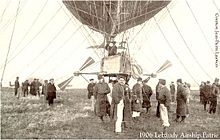Patrie (airship)
The Patrie was a semi-rigid airship built by the French company Lebaudy Frères and completed in November 1906. The first flight took place on November 16, 1906. On November 30, 1907, the airship could no longer be held by the 200-person ground crew during a storm. From Souhesme-la-Grande in France it floated unmanned across the British Channel , Wales and Ireland . It was last seen near the Hebrides .
history
After testing the Lebaudy airship in Toul , the French military ordered the similarly constructed Patrie at the end of 1905 .
The balloon envelope of the airship designed by Henri Julliot was created in the Lebaudy Frères factory in Moisson , the mechanical part in a workshop attached to their sugar factory in La Villette . The Patrie was a slightly enlarged version of the Lebaudy tested by the army in 1905 . The differences were a more powerful engine and the nacelle, which could be dismantled for possible transport by rail.
The first flight at Moisson took place on November 16, 1906. On board were the regular crew of the Lebaudy and the future crew of the Patrie . After six test drives, the military took down the airship on November 30th. On December 15, the transfer to Chalais-Meudon took place . After a trip through the center of Paris on December 17th, the Patrie was mothballed over the winter. The government ordered two more identical airships for delivery in 1907 (the République ) and 1908.
From June 27 to August 7, 1907, a series of 20 test and training drives took place. One of the highlights was the participation of the Patrie in the national holiday parade on July 14th in Longchamps in front of the French President. In August the gas filling was drained for minor modifications.
The third and final campaign with eleven climbs began on October 21. It was mostly routine performance tests. On November 23, the Patrie relocated to its future stationing location, 250 km away, Belleville near Verdun .
On their third trip from Belleville on November 29th, the engine failed on the way. Despite repair work at a height of 400 m, it could not be started again. In the afternoon the airship finally landed 17 km from its hangar at Souhesme-la-Grande . Numerous soldiers from the surrounding forts and neighbors secured it. The designer of the airship and a technician from the engine manufacturer were brought in.
When a storm hit during the night, it was not possible to deflate the balloon. The patrie , held by 200 men, tore itself away and drifted away. It has been sighted over Wales , Northern Ireland and most recently in the Hebrides .
After the loss of the patrie , the French army took over the airship Ville de Paris offered by Henry Deutsch de la Meurthe as a replacement and stationed it in Belleville from January 15, 1908.
The year after its end, the patrie became the subject of an alleged espionage affair when the Viennese architect August Krumholz , who had previously been in correspondence with Henri Julliot, was arrested in Paris on February 18, 1908. However, at Julliot's intervention, the procedure was put down, since, according to his statement, "the plans of the Patrie ... are known to the entire aeronautical world down to the smallest detail ... and have been published, commented on and discussed in all kinds of specialist publications".
description
The balloon envelope of the 62 m long Patrie consisted of two layers of rubber-coated cotton fabric. The envelope, filled with 3,500 m 3 of hydrogen gas, had a largest diameter of 10.3 m. The internal pressure of around 2.5 millibars ensured dimensional stability. A 650 m 3 air-fillable balloonet was built into the envelope .
The core of the semi-rigid airship was the tubular steel platform on the underside of the balloon envelope. A compact boat-shaped gondola made entirely of metal was suspended rigidly under the platform. It offered space for six people.
A 70 hp four-cylinder car engine made by Panhard & Levassor served as the drive . Two arms on the side of the nacelle-mounted metal propeller , each 2.50 m in diameter turning at 1000 min -1 .
In tests, the Patrie reached a height of over 2000 m and carried over 750 kg of stones as a load.
documentary
At the end of 1906, Alice Guy made “Le ballon dirigeable 'Le patrie'”, a one-minute documentary about Patrie . The airship is taken out of a hangar and takes off in front of an audience.
See also
Web links
Individual evidence
- ↑ a b c d A. de Masfrand: Le dirigeable militaire "Patrie". l'Aérophile, December 1906, pp. 299–306 , accessed on July 30, 2017 (French).
- ↑ a b c Le dirigeable le "Patrie" 1906 - 1907. Retrieved on July 30, 2017 (French).
- ↑ a b c d e Henri Julliot: Les dirigeables militaires. l'Aérophile, February 15, 1908, pp. 66-69 , accessed July 30, 2017 (French).
- ^ HW: Lebaudy Patrie. Historic Wings, November 16, 2012, accessed July 30, 2017 .
- ^ L. Lagrange: Le nouvel autoballon militaire français. l'Aérophile, February 1, 1908, pp. 45–49 , accessed on July 27, 2017 (French).
- ^ Wiener Luftschiff Zeitung, Internet Archive: An espionage affair
- ↑ Le ballon dirigeable 'Le patrie'. IMDb, accessed on August 20, 2017 .


